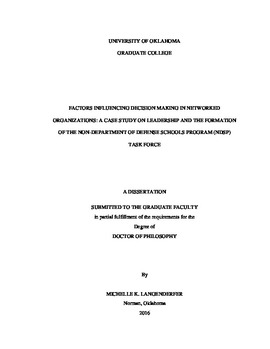| dc.description.abstract | The Department of Defense Education Activity (DoDEA) and the United States military fall under the purview of the Secretary of Defense. However, leaders at multiple levels within this organization do not systematically consider the requirements for the education of school-age children when developing new strategic military missions in overseas and remote locations worldwide where there are no DoDEA schools or adequate educational opportunities. During 2007 to 2010, the debate on who should fund the Non-DoD Schools Program (NDSP), a roughly $50 million ancillary program of DoDEA, shifted into a larger conversation on the importance of supporting the warfighter and the evolving military quality of life agenda to keep families together. Reoccurring concerns, such as quality of education, policy limitations, and increased budget requirements, from multiple organizations networked through a robust school council system resulted in a decision by the Director of DoDEA in spring 2010 to create a task force. Considering the challenges of advancing agendas in bureaucratic, hierarchical organizations, I used qualitative case study methods based on Yin’s (2009) five-component design to illuminate this decision-making process and to show how the topic of the NDSP elevated to the highest level of the school council system. Kingdon’s (1984) policy streams, policy entrepreneur and policy window model, underpinned with leadership and network theories, formed the theoretical framework. Punctuated Equilibrium Theory provided a rival explanation to add to discussion on incremental change, status quo, and abrupt change. A triangulation of three data sources (researcher memos, semi-structured interviews of former military and civilian members of the educational council system, and publically available documents) revealed a unique confluence of leadership at positional and Action Officer (AO) levels, changes in military missions, ongoing program transformations and the second and third order effects of previous decision-making that contributed to the outcome to create the task force. Leadership, communication, and relationships were prominent themes. This study has theoretical implications for organizational leaders at decision-making levels, and provides practical guidance for civilian and military AOs who endeavor to advance agendas effectively.
Keywords: organizational leadership, Kingdon, policy, network theory, DOD, decision-making, Punctuated Equilibrium | en_US |
